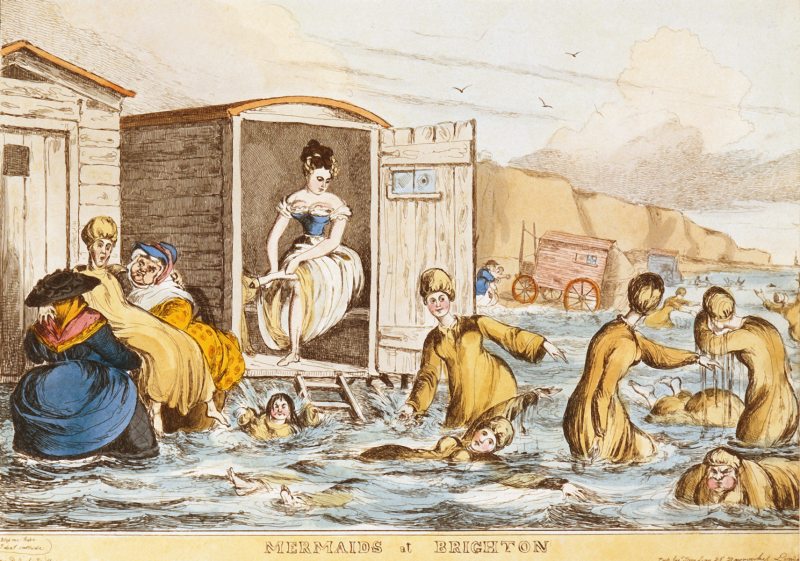Located on the southern coast of Great Britain, Brighton began its days as a humble fishing village. This all changed when George, Prince of Wales (later to become Regent) came to call in 1783. Brighton became his favorite getaway, thanks to the relaxed atmosphere. Here, he and his friends could do as they pleased without the prince's rigidly moral parents looking over his shoulder. The Prince loved the town, and the town loved him right back. Under the Prince's patronage, Brighton grew and grew, quickly transforming from a podunk backwater to the nation's premier resort.
The Prince of Wales' Brighton residence underwent a metamorphosis even more spectacular than that of the town itself. The Marine Pavilion was a gracious Georgian mansion. Take a peek:
 |
| There is nothing wrong with this house. |
By the time George became Regent, he'd been visiting Brighton for more than 25 years. He felt his abode was due a bit of pizzazz. To that end, the Prince Regent indulged his favorite pastime--begging money off Parliament--and did a little renovating.
_edited.jpg) |
| Just a bit. |
The exterior of the newly-styled Royal Pavilion was clearly informed by Eastern design. The interior was a Chinese fantasy land, replete with dragons, bamboo, lacquered cabinetry, Chinese wallpapers and lanterns, pagodas, and vivid colors. The Regent, who never traveled abroad, had a lifelong fascination with China. He imagined it to be a realm full of contented people, a dream of harmonious beauty and grace. In London, the Regent did constant battle with Parliament and his own ministers. He was ridiculed by a populace that found his passion for architecture, art, and music to be foolish. His marriage was a disaster of epic proportions. Even the weather was against him; the cold and damp aggravated his rheumatism and other complaints. The Royal Pavilion in Brighton was his escape. It--and by extension, the town--was a magical kingdom by the sea where the prince was free to indulge his every whim without fear of repercussion. In Brighton, George was respected and admired like he never was in London.
I have not forgotten all the other tourists, I promise. I wanted to give you some information about the Prince's involvement with Brighton, because he was the entire reason it became a tourist destination. When the Prince of Wales came to town, people followed. Initially, they were the Prince's entourage of friends--rich aristocrats, stylish ladies, and the trendsetters of the day--whom he lavishly entertained at the Pavilion. Eventually, visitors who were not part of the Prince's personal retinue came to Brighton to see what the fuss was all about.
 |
| Sports Illustrated Swimsuit Issue, 1826 |
The town boasted entertainments to suit every taste, high and low. Sea bathing was popular, as were the vapor baths (saunas). Plays and concerts provided theatrical amusement, while sport fans could take part in horse racing, bull baiting, and cockfighting. Middle class tourists who would never see the inside of the place enjoyed gawking at the opulent Royal Pavilion.
For the upper crust, the Steine was to Brighton what Hyde Park was to London. It was a green area first used by fishermen as a place to dry their nets. When the ton came to town, working folk were shoved aside and the Steine became the site of the afternoon fashionable hour, the place to stroll and mingle, to see and be seen. High-end merchants followed their wealthy clientele to Brighton and set up temporary shops which closed again when the moneyed horde left. After rounds of calls and shopping, the usual society balls and card parties filled evenings not spent at the Pavilion with the Regent.
Brighton was also notable for its tourist real estate properties. Houses were built special for the purpose of renting them to visitors for brief durations of time. New houses erected along the Steine were let for a week or two at a time. In this way, Brighton was truly innovative in encouraging tourism, making the town easily accessible to those early vacationers.
In the two centuries since the Regency, Brighton has continued on the path set by the Prince. It remains a popular tourist destination, hosting arts and music festivals, museums, and the ever popular beach fun. Brighton's nightlife has retained the freewheeling edge favored by the Prince Regent. The much-maligned Royal Pavilion still stands, and has become Brighton's most celebrated landmark. It is now open to the public and houses a museum to the Regency.
.jpg/800px-Brighton_Palace_(Royal_Pavilion).jpg) |
| Next stop: the Taj Ma--no, wait, still Brighton. |

Fascinating! Let's go visit next month for the Regent's birthday, shall we?
ReplyDeleteInteresting! Love the lessons!
ReplyDelete